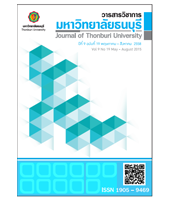การพัฒนารูปแบบการเรียนการสอนวิชาวิทยาศาสตร์ที่ส่งเสริมจิต 5 ลักษณะเพื่ออนาคต สำหรับนักเรียนชั้นมัธยมศึกษาปีที่ 1
Keywords:
รูปแบบการเรียนการสอน, วิชาวิทยาศาสตร์, จิต 5 ลักษณะเพื่ออนาคต, Instruction model, Science, Five minds for the futureAbstract
การวิจัยครั้งนี้มีวัตถุประสงค์ 1) เพื่อพัฒนารูปแบบการเรียนการสอนวิชาวิทยาศาสตร์ ที่ส่งเสริมจิต 5 ลักษณะเพื่ออนาคต สำหรับนักเรียนชั้นมัธยมศึกษาปีที่ 1 และ 2) เพื่อศึกษาประสิทธิผลของรูปแบบการเรียนการสอนวิชาวิทยาศาสตร์ ที่ส่งเสริมจิต 5 ลักษณะเพื่ออนาคต สำหรับนักเรียนชั้นมัธยมศึกษาปีที่ 1 การดำเนินการวิจัย มีดังนี้ ระยะที่ 1 การวิจัยเชิงสำรวจพฤติกรรมบ่งชี้จิต 5 ลักษณะเพื่ออนาคตของนักเรียนชั้นมัธยมศึกษาปีที่ 1 ประชากร คือ นักเรียนชั้นมัธยมศึกษาปีที่ 1 ภาคเรียนที่ 1 ปีการศึกษา 2556 จำนวน 835,068 คน กลุ่มตัวอย่าง คือ นักเรียนชั้นมัธยมศึกษาปีที่ 1 จำนวน 400 คน จากภาคเหนือ ภาคกลาง ภาคตะวันออกเฉียงเหนือ และภาคใต้ ได้มาโดยการใช้ตารางสำเร็จรูปของ Taro Yamane ที่ระดับความเชื่อมั่น 95% ใช้วิธีการสุ่มแบบหลายขั้นตอน ระยะที่ 2 การสร้างและพัฒนารูปแบบการเรียนการสอน วิเคราะห์ร่างรูปแบบการเรียนการสอนวิชาวิทยาศาสตร์ ที่ส่งเสริมจิต 5 ลักษณะเพื่ออนาคต โดยการหาค่าเฉลี่ย ส่วนเบี่ยงเบนมาตรฐานและการวิเคราะห์เนื้อหา วิเคราะห์แผนการเรียนการสอนและเครื่องมือวัดประสิทธิผลของรูปแบบ โดยการหาค่าดัชนีความสอดคล้อง (IOC) หาค่าความเที่ยง (Reliability) และการวิเคราะห์เนื้อหา โดยผู้เชี่ยวชาญ 5 ท่าน ระยะที่ 3 การประเมินประสิทธิผลของรูปแบบการเรียนการสอน กลุ่มตัวอย่าง คือ นักเรียนชั้นมัธยมศึกษาปีที่ 1 จำนวน 2 ห้องเรียน ได้มาด้วยการสุ่มแบบกลุ่ม โดยมีหน่วยการสุ่ม คือ ห้องเรียน แล้วสุ่มห้องเรียนที่ได้เป็นกลุ่มทดลองที่ใช้รูปแบบที่พัฒนาขึ้นและกลุ่มควบคุมที่สอนแบบปกติ สถิติที่ใช้ในการวิเคราะห์ข้อมูล ได้แก่ ร้อยละ ค่าเฉลี่ย ส่วนเบี่ยงเบนมาตรฐาน และการทดสอบค่าที
ผลการวิจัยมีดังนี้
1. ผลการสำรวจพฤติกรรมบ่งชี้จิต 5 ลักษณะเพื่ออนาคตตามแนวคิดของการ์ดเนอร์ ของนักเรียนชั้นมัธยมศึกษาปีที่ 1 พบว่านักเรียนมีจิตแห่งวิทยาการ จิตแห่งการสังเคราะห์ จิตแห่งการสร้างสรรค์ จิตแห่งความเคารพและจิตแห่งจริยธรรม โดยรวมและรายด้านอยู่ในระดับปานกลางทุกรายการ
2. รูปแบบการเรียนการสอนที่พัฒนาขึ้น มีองค์ประกอบ ได้แก่ (1) หลักการของรูปแบบ (2) วัตถุประสงค์ของรูปแบบ (3) ขั้นตอนการเรียนการสอน ได้แก่ ขั้นที่ 1 การลับสมอง ขั้นที่ 2 การจัดประสบการณ์ ขั้นที่ 3 การฝึกปฏิบัติและการพัฒนา และขั้นที่ 4 การสรุปสังเคราะห์ และ (4)การวัดและประเมินผล ผลการประเมินความเหมาะสมของแต่ละองค์ประกอบของรูปแบบการเรียนการสอนโดยผู้เชี่ยวชาญ อยู่ในระดับเหมาะสมมาก โดยมีค่าเฉลี่ยเท่ากับ 3.89
3. นักเรียนกลุ่มทดลองมีคะแนนเฉลี่ยโดยรวมและรายด้านความมีวินัยในตนเองทางการเรียน ความสามารถด้านการคิดสังเคราะห์ ความสามารถด้านการคิดสร้างสรรค์ การแสดงออกของพฤติกรรมด้านการเคารพและเข้าใจผู้อื่น การแสดงออกของพฤติกรรมด้านจริยธรรม หลังการทดลองสูงกว่ากลุ่มควบคุมอย่างมีนัยสำคัญทางสถิติที่ระดับ .05 แต่คะแนนผลสัมฤทธิ์ทางการเรียนของทั้งสองกลุ่มไม่แตกต่างกัน
4. นักเรียนกลุ่มทดลองที่ได้รับการสอนโดยใช้รูปแบบที่พัฒนาขึ้นมีคะแนนเฉลี่ยในแต่ละด้านและโดยรวมหลังการทดลองสูงกว่าก่อนทดลองอย่างมีนัยสำคัญทางสถิติที่ระดับ .05
THE DEVELOPMENT OF A SCIENCE INSTRUCTION MODEL ENHANCING FIVE MINDS FOR THE FUTURE FOR MATHYOM SUKSA 1
The objectives of this research were 1) to develop a science instruction model enhancing five minds for the future for Mathayom Suksa I students; and 2) to study the effectiveness of the science instruction model enhancing five minds for the future for Mathayom Suksa I students. The research process comprised the following phases: The first phase was a survey of Mathayom Suksa I students’ behavior characteristics indicating five minds for the future. The research population comprised 835,068 Mathayom Suksa I students studying in the first semester of the 2013 academic year. The research sample consisted of 400 Mathayom Suksa I students from schools in the Northern, Central, North Eastern, and Southern regions, obtained by multi-stage sampling. The sample size was determined based on Taro Yamane’s Sample Size Table at the 95 per cent confidence level. The second phase was the development of the science instruction model enhancing five minds for the future for Mathayom Suksa I students. In this phase the first draft of the science instruction model enhancing five minds for the future for Mathayom Suksa I students was developed by the researcher. Then, it was submitted to be analyzed by five experts using the mean, standard deviation, and content analysis. The instructional management plans and the model effectiveness evaluation form were also analyzed using the IOC index, reliability coefficient, and content analysis. The third phase was the effectiveness evaluation of the developed model. The research sample consisted of Mathayom Suksa I students in two intact classrooms obtained by cluster sampling. Then students in one classroom were randomly assigned as the experimental group to learn under the developed model; students in the other classroom, the control group to be taught by conventional teaching. Statistics employed for data analysis were the percentage, mean, standard deviation, and t-test.
Research findings were as follows:
1. The survey results of Mathayom Suksa I students’ behavior characteristics indicating five minds for the future based on Gardner’s concepts showed that both the overall and by-aspect levels of the students’ five minds for the future, namely, the discipline mind, the synthesizing mind, the creating mind, the respectful mind, and the ethical mind were at the moderate level.
2. The developed science instruction model had the following components: (1) the model rationale; (2) the model objectives; (3) the steps of instruction which comprised four steps, namely, the first step: sharpening of the mind, the second step: provision of experience, the third step: practice and development, and the fourth step: synthesized conclusion; and (4) the measurement and evaluation. Evaluation results of appropriateness of each component by the experts showed that all components were appropriate at the high level, with the rating mean of 3.89.
3. The experimental group students’ post-experiment overall and by-aspect rating means of their self-discipline in learning, synthesis thinking ability, creative thinking ability, exhibited respectful behaviors and sympathy for the others,and exhibited ethical behaviors were significantly higher than the counterpart rating means of the control group students at the .05 level. However, learning achievement scores of the two groups were not significantly different.
4. The experimental group students, who were taught with the use of the developed science instruction model, had their post-experiment overall and by-aspect mean scores significantly higher than their pre-experiment counterpart mean scores at the .05 level.







